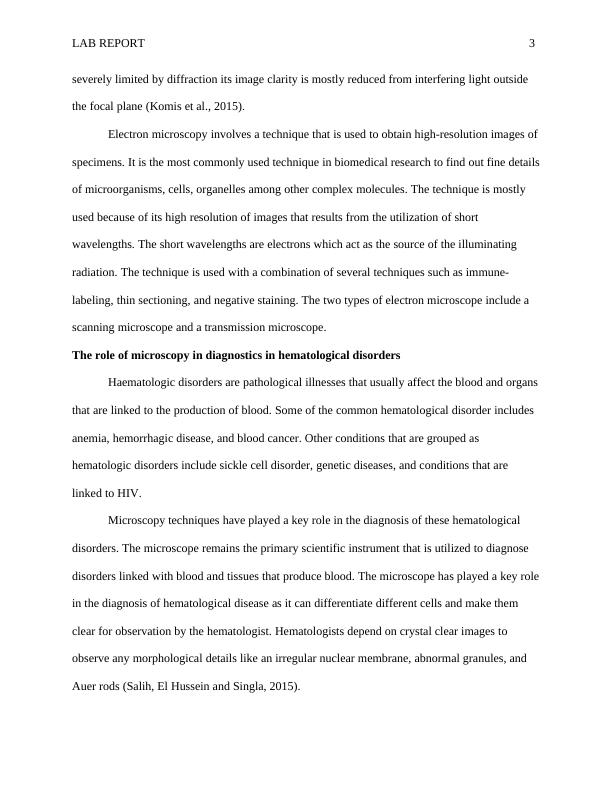Assignment on Lab Report - 1
7 Pages1422 Words19 Views
Added on 2022-09-26
Assignment on Lab Report - 1
Added on 2022-09-26
ShareRelated Documents
LAB REPORT 1
LAB REPORT
Course name
Professor’s name
University name
City, State
Date of Submission
LAB REPORT
Course name
Professor’s name
University name
City, State
Date of Submission

LAB REPORT 2
Introduction
This lap report examines complete biopsy of lymph node and effacement of the lymph node.
Besides, it examines the variable proportions of lymphocytes eosinophil, plasma cells as well as
histiocytes and lymphocytes. Broadly discusses microscopic methods that are utilized in science
to diagnose and study the underlying biochemical as well as molecular processes of
microorganisms. It describes different types of microscope that have been developed and are
being used in the modern world. Furthermore, the paper describes the role of microscopy in
diagnostic testing particularly in hematological diseases. Besides, the paper explores
contemporary and newly emerging approaches of microscopy with their application in
hematology.
Microscopy methods
Microscopy can be defined as the practice of science that uses a microscope to determine
microscopic samples and substances that cannot be seen by a naked eye. Its discovery has
revolutionized science and particular, microbiology (Chen, Tillberg, and Boyden, 2015)
There are different types of microscopy and the commonly used types include optical
microscopy, electron and scanning probe microscopy. Optical microscopy also referred to as a
light microscope is the most common type of microscopy that involves magnifying the image of
the object by reflecting light off it. It is a technique that employs close viewing of a sample via
the magnification of lens with light. It is the traditional form of microscopy that was invented
back in the 18s and it is still being used on a small scale. It uses a series of lenses to magnify
images of tiny samples with the use of visible light. The light microscope has its weaknesses in
that it works at its best only in darker samples that refract effectively. Also, its resolution is
Introduction
This lap report examines complete biopsy of lymph node and effacement of the lymph node.
Besides, it examines the variable proportions of lymphocytes eosinophil, plasma cells as well as
histiocytes and lymphocytes. Broadly discusses microscopic methods that are utilized in science
to diagnose and study the underlying biochemical as well as molecular processes of
microorganisms. It describes different types of microscope that have been developed and are
being used in the modern world. Furthermore, the paper describes the role of microscopy in
diagnostic testing particularly in hematological diseases. Besides, the paper explores
contemporary and newly emerging approaches of microscopy with their application in
hematology.
Microscopy methods
Microscopy can be defined as the practice of science that uses a microscope to determine
microscopic samples and substances that cannot be seen by a naked eye. Its discovery has
revolutionized science and particular, microbiology (Chen, Tillberg, and Boyden, 2015)
There are different types of microscopy and the commonly used types include optical
microscopy, electron and scanning probe microscopy. Optical microscopy also referred to as a
light microscope is the most common type of microscopy that involves magnifying the image of
the object by reflecting light off it. It is a technique that employs close viewing of a sample via
the magnification of lens with light. It is the traditional form of microscopy that was invented
back in the 18s and it is still being used on a small scale. It uses a series of lenses to magnify
images of tiny samples with the use of visible light. The light microscope has its weaknesses in
that it works at its best only in darker samples that refract effectively. Also, its resolution is

LAB REPORT 3
severely limited by diffraction its image clarity is mostly reduced from interfering light outside
the focal plane (Komis et al., 2015).
Electron microscopy involves a technique that is used to obtain high-resolution images of
specimens. It is the most commonly used technique in biomedical research to find out fine details
of microorganisms, cells, organelles among other complex molecules. The technique is mostly
used because of its high resolution of images that results from the utilization of short
wavelengths. The short wavelengths are electrons which act as the source of the illuminating
radiation. The technique is used with a combination of several techniques such as immune-
labeling, thin sectioning, and negative staining. The two types of electron microscope include a
scanning microscope and a transmission microscope.
The role of microscopy in diagnostics in hematological disorders
Haematologic disorders are pathological illnesses that usually affect the blood and organs
that are linked to the production of blood. Some of the common hematological disorder includes
anemia, hemorrhagic disease, and blood cancer. Other conditions that are grouped as
hematologic disorders include sickle cell disorder, genetic diseases, and conditions that are
linked to HIV.
Microscopy techniques have played a key role in the diagnosis of these hematological
disorders. The microscope remains the primary scientific instrument that is utilized to diagnose
disorders linked with blood and tissues that produce blood. The microscope has played a key role
in the diagnosis of hematological disease as it can differentiate different cells and make them
clear for observation by the hematologist. Hematologists depend on crystal clear images to
observe any morphological details like an irregular nuclear membrane, abnormal granules, and
Auer rods (Salih, El Hussein and Singla, 2015).
severely limited by diffraction its image clarity is mostly reduced from interfering light outside
the focal plane (Komis et al., 2015).
Electron microscopy involves a technique that is used to obtain high-resolution images of
specimens. It is the most commonly used technique in biomedical research to find out fine details
of microorganisms, cells, organelles among other complex molecules. The technique is mostly
used because of its high resolution of images that results from the utilization of short
wavelengths. The short wavelengths are electrons which act as the source of the illuminating
radiation. The technique is used with a combination of several techniques such as immune-
labeling, thin sectioning, and negative staining. The two types of electron microscope include a
scanning microscope and a transmission microscope.
The role of microscopy in diagnostics in hematological disorders
Haematologic disorders are pathological illnesses that usually affect the blood and organs
that are linked to the production of blood. Some of the common hematological disorder includes
anemia, hemorrhagic disease, and blood cancer. Other conditions that are grouped as
hematologic disorders include sickle cell disorder, genetic diseases, and conditions that are
linked to HIV.
Microscopy techniques have played a key role in the diagnosis of these hematological
disorders. The microscope remains the primary scientific instrument that is utilized to diagnose
disorders linked with blood and tissues that produce blood. The microscope has played a key role
in the diagnosis of hematological disease as it can differentiate different cells and make them
clear for observation by the hematologist. Hematologists depend on crystal clear images to
observe any morphological details like an irregular nuclear membrane, abnormal granules, and
Auer rods (Salih, El Hussein and Singla, 2015).

End of preview
Want to access all the pages? Upload your documents or become a member.
Related Documents
Introduction to Biological Macromoleculeslg...
|12
|2003
|241
Comparison of Microscopy Techniqueslg...
|16
|3493
|249
Electron Microscopy Of Subcellular Structurelg...
|9
|2408
|169
ONLINE DISUSSION.lg...
|3
|387
|309
Techniques Used to Study Structures of Animal Celllg...
|6
|1101
|340
(PDF) An Overview of Cancer Treatment Modalitieslg...
|9
|2031
|122
